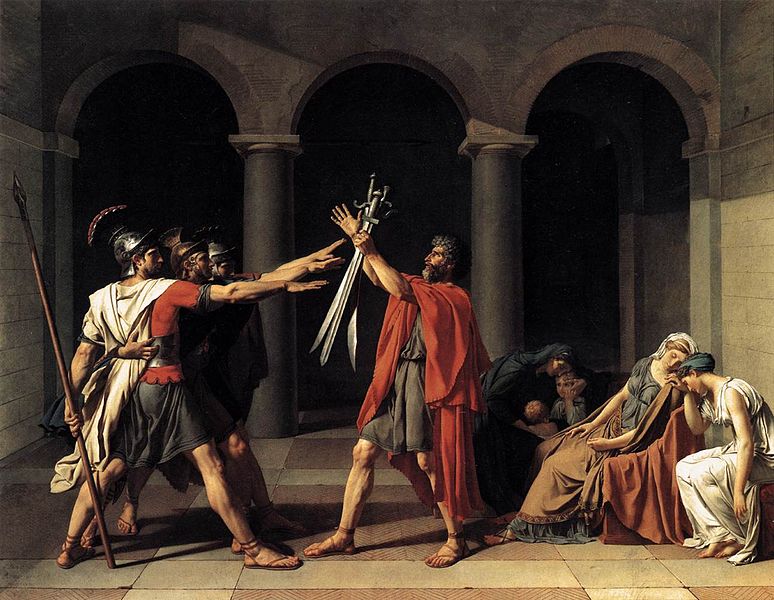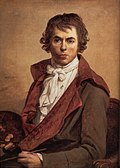Archivo:David-Oath of the Horatii-1784.jpg

Este archivo es de Wikimedia Commons y puede usarse en otros proyectos. La descripción en su página de descripción del archivo se muestra debajo.
Resumen
| Jacques-Louis David: Juramento de los Horacios
|
||||||||||||||||||||||||||||
|---|---|---|---|---|---|---|---|---|---|---|---|---|---|---|---|---|---|---|---|---|---|---|---|---|---|---|---|---|
| Artista |
artist QS:P170,Q83155 |
|||||||||||||||||||||||||||
| Título |
English: The Oath of the Horatii Русский: Клятва Горациев Français : Le Serment des Horaces Türkçe: Baba ve üç oğlunun savaş yeminidir arka plandakiler eşler ve kız kardeşlerdir. |
|||||||||||||||||||||||||||
| Object type |
pintura |
|||||||||||||||||||||||||||
| Género |
pintura de historia |
|||||||||||||||||||||||||||
| Personas retratadas |
Publio Horacio |
|||||||||||||||||||||||||||
| Fecha |
1784 date QS:P571,+1784-00-00T00:00:00Z/9 |
|||||||||||||||||||||||||||
| Técnica |
óleo sobre tela medium QS:P186,Q296955;P186,Q12321255,P518,Q861259 |
|||||||||||||||||||||||||||
| Dimensiones |
altura: 330 cm; ancho: 425 cm dimensions QS:P2048,330U174728 dimensions QS:P2049,425U174728 |
|||||||||||||||||||||||||||
| Colección |
institution QS:P195,Q19675 |
|||||||||||||||||||||||||||
| Ubicación actual |
Louvre, Paris, France |
|||||||||||||||||||||||||||
| Número de inventario |
3692 |
|||||||||||||||||||||||||||
| Lugar de creación |
Roma |
|||||||||||||||||||||||||||
| Exhibition history |
|
|||||||||||||||||||||||||||
| Inscripciones |
|
|||||||||||||||||||||||||||
| Notas | Das Bild verstand sich als Initialbild einer neuen Kunstrichtung und kehrte sich sowohl im Thema, als auch in der Gestaltung radikal von der vorhergehenden Kunstrichtung ab. | |||||||||||||||||||||||||||
| Referencias | http://cartelen.louvre.fr/cartelen/visite?srv=car_not_frame&idNotice=22497&langue=en | |||||||||||||||||||||||||||
| Control de autoridades | ||||||||||||||||||||||||||||
| Fuente/fotógrafo |
Web Gallery of Art: reference_wga QS:P973,"http://www.wga.hu/html/d/david_j/2/201david.html" |
|||||||||||||||||||||||||||
| Otras versiones | Jacques-Louis David 020.jpg | |||||||||||||||||||||||||||
Licencia
|
Esta es una reproducción fotográfica fiel de una obra de arte bidimensional de dominio público. La obra de arte misma se halla en el dominio público por el motivo siguiente:
La postura oficial de la Fundación Wikimedia considera que «las reproducciones fieles de obras de arte bidimensionales de dominio público forman parte del dominio público».
Esta reproducción fotográfica, por ende, también se considera de dominio público dentro de los Estados Unidos. Es posible que otras jurisdicciones restrinjan la reutilización de este contenido; consúltese Reutilización de fotografías PD-Art (en inglés) para más detalles. | |||||
| Annotations InfoField | This image is annotated: View the annotations at Commons |
Dieses Bild mit seiner strengen, zeichnerisch bestimmten Komposition auf klar begrenzter Raumbühne, wurde von den Zeitgenossen als das Programmbild des Klassizismus verstanden. Es ist erfüllt von moralischem Pathos und tritt thematisch für sittlichen Ernst und Menschenwürde ein - somit ein politisch motiviertes Bild.
Leyendas
Elementos representados en este archivo
representa a
image/jpeg
12cbda9f7154ee87f6a80382ff6d145acaed4d9b
157 290 byte
1001 píxel
1292 píxel
Historial del archivo
Haz clic sobre una fecha/hora para ver el archivo a esa fecha.
| Fecha y hora | Miniatura | Dimensiones | Usuario | Comentario | |
|---|---|---|---|---|---|
| actual | 21:38 10 abr 2007 |  | 1292 × 1001 (154 KB) | Grendelkhan | {{Painting| |Title={{en|The Oath of the Horatii}} |Technique={{en|Oil on canvas}} |Dimensions=129 3/4 x 167 1/8 inches (329.8 x 424.8 cm) |Location=Paris, France |Country= |Gallery=Louvre |Notes= |Source=[http://www.wga.hu/frames-e.html?/html/d/david_ |
Usos del archivo
La siguiente página enlaza a este archivo:
Metadatos
| Comentario de archivo JPEG | DAVID, Jacques-Louis
(b. 1748, Paris, d. 1825, Bruxelles) The Oath of the Horatii 1784 Oil on canvas, 330 x 425 cm Musée du Louvre, Paris David owed his rise to fame - after many reversals - to a painting for the execution of which he took his family to Rome, in order to absorb himself totally in the world of antique forms. It was The Oath of the Horatii. When he arrived to Rome, David rent a studio in the Via del Babuino. He worked in a very methodical manner on The Oath of the Horatii, drawing from life models and draped mannequins, and some very detailed studies survive for many of the main figures. He had accessories such as the swords and helmets made by local craftsmen so that they could serve as props. Drouais is supposed to have assisted David, painting the arm of the rear Horatii brother and the yellow garment of Sabina. The painting was finished at the end of July 1785, and was then exhibited in David's studio. David signed the painting and added the painting's place of origin to the signature and date: L David / faciebat / Romanae /Anno MDCCLXXXIV. The painting created a sensation, even the Pope wanted to view it. The story is from the 7th century B.C., and it tells of the triplet sons of Publius Horatius, who decided the struggle between Rome and Albalonga. One survived, but he killed his own sister because she wept for one of the fallen foes, to whom she was betrothed. Condemned to death for the murder of a sibling, Horatius' son is pardoned by the will of the people. Because of its austerity and depiction of dutiful patriotism, The Oath of the Horatii is often considered to be the clearest expression of Neoclassicism in painting. The painting's uncompromising directness, economy and tension made it instantly memorable and full of visual impact. Each of the three elements of the picture - the sons, the father and the women - is framed by a section of a Doric arcade, and the figures are located in a narrow stage-like space. David split the picture between the masculine resolve of the father and brothers and the slumped resignation of the women.. The focal point of the work is occupied by the swords that old Horatius is about to distribute to his sons. While the rear two brothers take the oath with their left hands, the foremost one swears with his right. Perhaps David did this simply as a way of grouping the figures together, but people at the time noticed this detail, and some supposed that this meant that the brother in the front would be the one to survive the combat.
Author: DAVID, Jacques-Louis Title: The Oath of the Horatii Form: painting Time-line: 1801-1850 School: French Type: historical |
|---|


